Brand Maria Sharapova
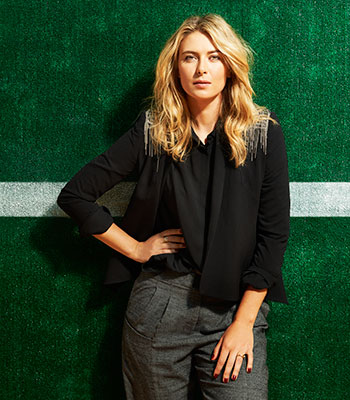
Simply sign up to the Life & Arts myFT Digest -- delivered directly to your inbox.
Maria Sharapova appears in the hotel lobby in canary yellow shorts and a grey sweater, her face still flushed from an hour-long workout in the gym.
“Hi, I’m Maria,” she says, extending a hand.
The introduction is polite, but hardly necessary. Sharapova has one of the most recognisable — and marketable — faces in the world. She became an overnight sensation more than a decade ago, as the tall, blonde, preternaturally cool tennis player who won her first Wimbledon title aged only 17. In the years since, she has added another four grand slam titles to her name, becoming one of just 10 female players to win at least once in Melbourne, Paris, Wimbledon and New York — the most coveted titles in tennis.
Her sporting triumphs have been matched perhaps only by her success off the court. Sharapova has only rarely been the very best tennis player in the world — but she has long been the sport’s biggest brand. Through victory and through defeat, Sharapova has topped the Forbes ranking of the world’s highest-paid female athlete every year for the past decade.
Nike, Porsche, Evian, Tag Heuer and a raft of other companies pay her more than $20m in annual endorsements (four times her earnings from prize money in 2014). In return, they get to place her image alongside their products on billboards, magazines and screens worldwide. They also gain access to her vast following on social media, which has reached 1.6 million on Twitter and nearly 15 million on Facebook. She has her own web app, and is building a candy-to-clothing business that is already present in 30 markets. Sharapova is more than familiar; she is ubiquitous.
Sharapova smiles and apologises for her state, before disappearing to her room for a shower. She returns 10 minutes later, dressed in a black pullover, grey cotton trousers and black trainers. It is an unseasonably cold day in Madrid, and she has brought along a woollen shawl that she winds around her body every time a fresh gust of wind blows in from the hotel door.
I had expected Sharapova to arrive with an agent or spokesperson in tow but, aside from a couple of well-dressed businessmen, we have the lobby bar to ourselves. As her veteran agent tells me a few days later, “There are a lot of tennis players who need someone to hold their hand. We have never been like that . . . she is very secure.” Sharapova orders a pot of English breakfast tea and settles down on a high-backed crimson sofa.
She is in the Spanish capital to compete in the Madrid Open, a clay court tournament that ranks just below the grand slam events for importance. She won the title here last year, before battling her way to an emotional second victory in Paris. At 28, Sharapova knows she only has a few more years left to add to her haul of titles.
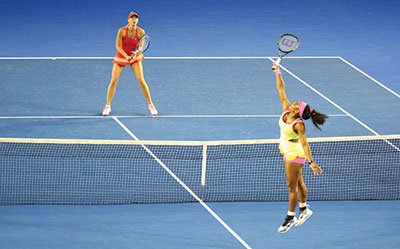
Her ambition clearly burns as brightly as ever but there is a subtle change in motivation. “If I ever needed to prove anything to anyone else I think I have,” she says. “Now, anything I achieve is more for me and my own gratefulness than anything else.”
Sharapova, of course, has plenty of reasons to feel grateful as it is. Her last two grand slam titles (both in Paris) came after tearing her rotator cuff, a potentially career-ending shoulder injury that required surgery in late 2008. She couldn’t play tennis for nine months, missed two grand slams and dropped to 126 in the rankings — her first spell outside the top 100 since 2003. It would take her three years to struggle back into a grand slam final, and four to actually win one. The shoulder has given her trouble on several occasions since, most recently in late 2013.
“The toughest part was not really having many examples of people who came back from shoulder injury,” she recalls. “I was never able to think of someone and say to myself, ‘OK, they went through this and got back their strokes.’”
Indeed, neither did Sharapova. “It put a lot of doubts in my game. My game was based on being powerful and hitting very deep strokes. The serve especially was really challenging because all of a sudden I was losing my speed, I was losing my feel . . . The way I was able to serve as a 17-year-old, my shoulder will never be able to support that again.”
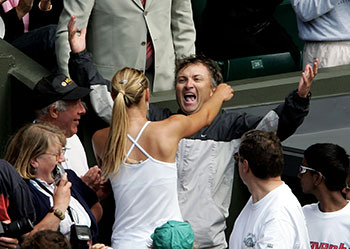
Sharapova ended up reinventing key parts of her game — essentially swapping raw power for a more patient, tactical approach. Her serve has lost its early-career bite but she has vastly improved her return and added new facets to her game, most notably the drop shot. In most matches, Sharapova will try to occupy a central position just inside the baseline. From here, she can dictate the run of play, whipping the ball from one side of the court to the other, and forcing her opponent into a desperate, exhausting chase until she sees the chance to put the ball out of reach.
It is a style of play that suits slower surfaces such as clay better than grass and hard courts. All her grand slam titles before her operation came on fast courts. Her two grand slam trophies since have been on clay — in Paris — as was her most recent tournament win, in Rome last week. Returned to the number two position in the WTA ranking, she will try to defend her French Open title starting this weekend — and rekindle her decade-long quest to beat the world number one, Serena Williams.
The one constant in Sharapova’s game — and her most powerful weapon on court by some distance — is her mind. She never shows nerves. She never gives up. She often plays her best tennis, her hardest, longest strokes and her most daring drop shots precisely when the pressure on her is greatest. She runs after balls she knows she has little chance of reaching — and nine out of 10 times she won’t. But once every so often, Sharapova will somehow scoop that impossible ball back across the net. What counts is the message she sends to her opponents: I will fight you all the way.

“There is nobody out there who is more intense, point for point, week in week out than Maria,” Chris Evert, the former multiple-grand-slam winner, tells me. “I have watched her so many times when she’s been losing, when she is down a set and a break or a set and two breaks. And then the fight comes out. She comes back better than anyone. The fighter aspect always amazes me.”
To play the way she does, Sharapova has to nurse her strength. She competes in fewer tournaments than other players and occasionally takes time off from the official tour schedule (“Maria time”, as her entourage calls it). “In order to be explosive and have that sort of energy you need motivation and will. So I have always structured my schedule in a way that, when the time comes to push myself, I am fresh enough to do that,” she says.
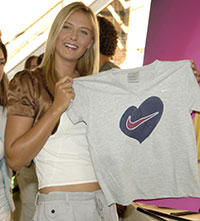
So what does she do during “Maria time”?
Sharapova looks momentarily confused. “I like to work,” she replies. “It’s hard for me not to do much, and it’s hard for me to sit still. I like to do things.”
The steely determination that marks modern athletes often triggers a somewhat futile search for the origins of their disposition. In the case of Sharapova, that quest invariably leads to her childhood. Born in Nyagan, western Siberia, in 1987, she started playing tennis as a four-year-old, after her parents moved to the Black Sea resort of Sochi. When she was six, she was spotted by Martina Navratilova during a tennis exhibition in Moscow. The former world number one told Sharapova’s parents to send her to the US for proper training — prompting a dramatic turn in the little girl’s life.
Sharapova arrived in the US a few weeks shy of her seventh birthday, to start training at the Nick Bollettieri Academy in Florida. She spoke no English, and her father had to work odd jobs around town to make ends meet (her mother only joined them two years later). “My dad was working sometimes a couple of hours away, so I wouldn’t see him for a week or two. I was living in a dormitory with girls who were much older than me,” she recalls, adding: “I was never part of the rat pack.”

Anyone looking for psychological clues — the lonely, motherless Russian girl hardened by a strange and hostile environment — will be disappointed. “I was living my dream,” exclaims Sharapova. “I was a young kid who loved to play tennis, playing tennis at one of the best academies in the world. I saw Agassi, I saw Monica Seles. I saw all these great champions come through and practise. And I woke up every morning and couldn’t wait for my alarm to ring at 6.30am and go and have my lesson.” It was, she insists, a “really neat experience”.
. . .
Not being part of the gang has never bothered Sharapova, who has a reputation for being aloof on tour. Her entourage is minimal. The loneliness that professional tennis inflicts on its practitioners does not seem to trouble her. Most players spend 10 months on the road, moving from hotel to hotel, arena to arena. The game itself is an almost uniquely individualistic endeavour. There is no home base and no familiar crowd. There are no team mates, and no shared sorrow or joy (except, perhaps, with the coaching staff who sit in the players’ box). It is just the athlete and her racket, defending a vast, vulnerable space against the onslaught from the other side. Apart from a brief chat in the dressing room and the handshake after the match, tennis requires little contact between players.

“The sport makes you forget very fast, which in a way is quite sad,” says Sharapova. “Last year I won the title here but I don’t really have too many memories. It was a tough final. We rushed back to the hotel, got our bags, got on the plane and I was in Rome playing two days later.”
For Sharapova, of course, the intercontinental tennis carousel came to an abrupt halt after her shoulder injury. “Since the age of four, my tennis career was sort of on automatic. You wake up, train, take an aeroplane, play a tournament and go back home. All of a sudden, I had an injury that was basically a stop sign. You can’t play, and you can’t have a career for the next six to 12 months. It is a strange feeling.”
For the first time in many years, Sharapova found time to think, not least about her life after tennis. Worried that her professional career might be over sooner than she had hoped, she decided to set herself up as a businesswoman. Sharapova had already spent years working with companies such as Nike and Tiffany, occasionally helping to design products sold under her name.
“In the end, I was always a very small part of these brands. But I wanted to start something that was mine, where I felt the pressure and privilege of owning a brand, and where I had to make the final decision,” she says.

Together with Max Eisenbud, her long-time agent, Sharapova developed plans for a high-end candy business called Sugarpova that was eventually launched in 2012. Wholly owned and financed by Sharapova, the company makes colourful and smartly packaged gummies, sweets and chewing gum, with flavours branded as “Flirty”, “Cheeky” or “Sporty”. There is little financial information about the company but Eisenbud tells me that Sugarpova has sold 3.5 million bags of candy in its first two years, and is now present in 30 markets. “We are growing like crazy,” he says.

Sharapova sees the candy business as just the start. Sugarpova has already branched out into selling accessories such as T-shirts and jewellery. Next in line are chocolates and mints, and eventually Sharapova and Eisenbud plan to extend the brand into fragrances and fashion. “My vision is for this to become a lifestyle brand,” says Sharapova (who has mastered the vernacular of the marketing world to perfection). “That doesn’t necessarily tie in to a food product. But in order to get lifestyle recognition I want to build the brand around candy.”
Both Sharapova and Eisenbud say their long-term goal is to establish a “House of Sugarpova” collection of brands and products. It sounds ambitious but not outlandish, especially given the history of the Sharapova-Eisenbud partnership, one of the most lasting and lucrative in modern sport.
Eisenbud claims he spotted Sharapova’s potential immediately. He had just been hired as a junior agent at IMG, the sports marketing group, and was touring the courts of the Bollettieri Academy when he set eyes on a 12-year-old Russian talent whacking balls across the court with stunning intensity.
“I didn’t know anything about her but I just stopped in my tracks. She was so skinny, like a piece of spaghetti, but her concentration and focus were unbelievable,” he recalls. “Did you ever see the footage of Tiger Woods hitting a golf ball when he was seven or eight years old? This was the same. It was obvious she would be a star.”
I ask Eisenbud why Sharapova is so valuable to advertisers. The question is more sensitive than it seems. Sport is supposed to be the ultimate meritocracy, where the best player wins the most trophies and earns the most money. It has not been that way in women’s tennis, however. Serena Williams has won 19 grand slam titles to Sharapova’s five, twice as many titles overall and double Sharapova’s prize money. As Rolling Stone magazine once wrote, Williams “runs women’s tennis like Kim Jong Un runs North Korea”. And yet, every year for the past decade, it is Sharapova that has come out on top financially.

Why the discrepancy? “The obvious answer is that she is a very attractive girl, that she is marketable and has done a lot of winning,” replies Eisenbud. “The real answer, however, is that she is very savvy, she is a very smart businesswoman — and she understands return on investment. She understands that if Porsche or Evian are paying her a lot of money, the only way that money will keep on flowing is if she helps them with their goals and objectives.
“I think a lot of athletes don’t understand that. They think, I’m great and someone will pay me. But when Maria is at a photo shoot she wants everything to be perfect. She asks, ‘Do you have everything you want? Do you want to shoot this again?’ She is very special like that.”
Eisenbud believes that Sugarpova will provide the perfect outlet for Sharapova’s competitive drive once her tennis career is over. Just when that will be, however, is hard to predict. Sharapova herself says she has “no idea” when she will quit but insists that the idea of retirement holds no fear for her. “When I was injured, I never thought I would be playing at 28,” she remarks. “I have had a lot of incredible experiences [as a player] and I hope I will have many more. But, believe me, I will be very happy when I finish. There will be no regrets. I want to have family time. I want to have kids.”
For the past couple of years, Sharapova has been going out with Grigor Dimitrov, the 23-year-old Bulgarian tennis player (the two are the tour’s glamour couple, and a favourite target for paparazzi from Rome to Los Angeles). Currently ranked 11, he is regarded as one of the biggest talents on the tour, though he has yet to record his first grand slam win.
“It’s nice to have someone who really understands and respects [what I do] and who knows the drill,” says Sharapova when I ask her about the relationship. “There are so many little variants in an athlete’s career that are not always easy to explain to the outside world. So it is nice that they are aware of it and know it.”
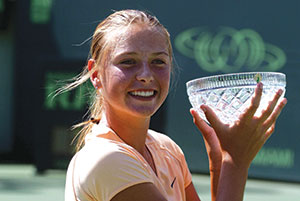
If Sharapova fails to win Paris this year — or anywhere else for that matter — it will not be for a lack of willpower or fight. It will be because Sharapova’s professional career has overlapped with that of arguably the greatest female tennis player of all time, her eternal rival and perpetual nemesis, Serena Williams.
She beat Williams, surprisingly comfortably, in that breakthrough 2004 Wimbledon final. Giggling her way through the post-match interview on court, the teenage Sharapova turned to her opponent and said: “I know there will be so many more moments when we will play [each other] . . . and fight for the trophy. Thank you for giving me a tough match but I am sorry — I had to win today.”
It turned out she was tempting fate. Since 2004, the two players have met on 16 occasions, and Williams won every single one of their encounters, usually in straight sets. The decade-long duel has been so one-sided that some fans scoff at the idea of a proper rivalry. But Chris Evert, who went through similar phases in her legendary contest with Martina Navratilova, disagrees.
“In a lot of people’s minds, this is a non-rivalry,” she says. “But it is a rivalry in the tennis world, because rivals are studies in contrast. And there is so much contrast here, in anything from temperament to looks to game style. Everyone in the tennis world is always intrigued when we watch the two, to see whether this is the one time that Maria Sharapova beats Serena Williams.”
The last important match between the two was in the final of the Australian Open in January. Williams triumphed — again — but the match (6-3, 7-6) was closer than other recent encounters. The second set in particular turned into a raw, fierce, exhilarating contest. Sharapova was defeated, ultimately, by the power and accuracy of Williams’ serve — the best the women’s game has ever seen. She served 18 aces in the match, of which 15 came in the crucial final set. And yet, despite the stinging defeat, Sharapova came away thinking that she can, after all, beat her great rival.
“The thing about my matches with Serena is that there have been some very easy scorelines. And there have been matches where I have formed opportunities, where I formed little door openings — and then they slipped away. Melbourne was another occasion like that.
“When you play against the number one, a lot of things have to work for you. You cannot make unforced errors, you cannot give away easy points, you cannot give her confidence, you can’t be playing at the highest level all the time. What is important is to take advantage of the moments when her ball is coming a bit short or when you have opportunities with her second serve.”
Does she think she can beat Williams one day? There is not a second’s hesitation: “Absolutely.”
Tobias Buck is the FT’s Madrid bureau chief
Portrait by Spencer Lowell
Eye Forward Inc; Hair: Adir Abergel; Studio: The Studio, Los Angeles; Assistants: Trever Gens and Brendan Pattengale; Getty; PA; EPA
This article was amended on May 22 2015 to reflect that the $20m in endorsements that Maria Sharapova received in 2014 represents four times her earnings from prize money
Comments